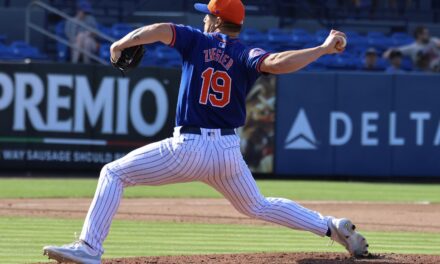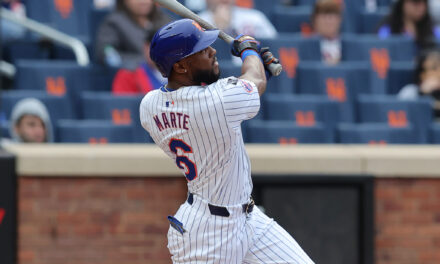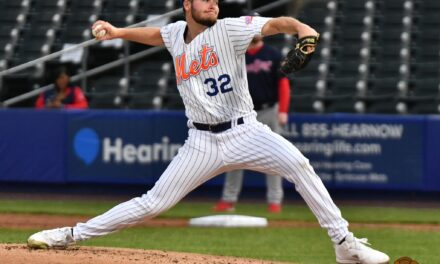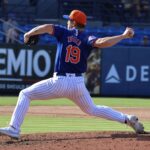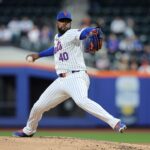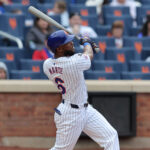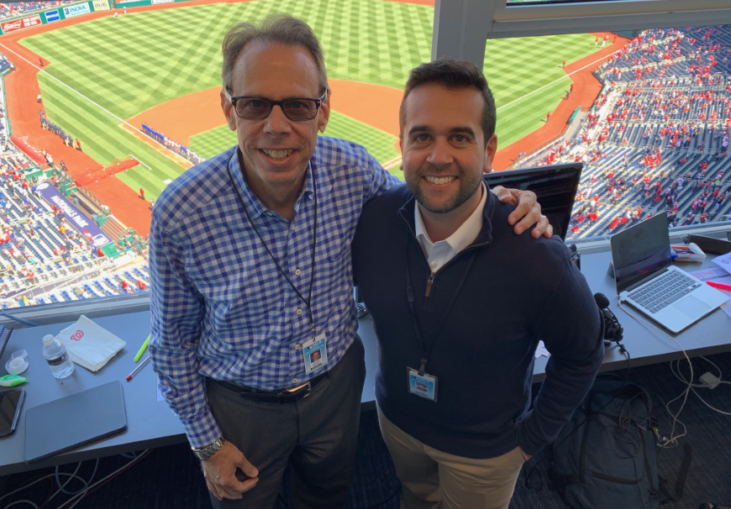
On December 19, it was reported that Wayne Randazzo will not return to the Mets’ radio broadcast booth for the 2023 season. Reports are that Randazzo will be the next play-by-play announcer on TV for the Angels. His now former partner calling Mets games, Howie Rose, had this to say on Twitter:
I’m not at liberty yet to comment on @WayneRandazzo’s next move, but it’s all good and I am thrilled for him.
— Howie Rose (@HowieRose) December 19, 2022
The Mets’ radio booth has expectedly seen turnover during the team’s 61 years of existence. Let’s take a look back at the voices who have brought Mets games to our transistor radios, automobiles, and now streaming devices since 1962
1962-1978
For the Mets’ first 17 seasons, both the television and radio booths were remarkably stable. As was customary in those days, the Mets used a three-man rotating schedule, with the broadcasters doing both radio and television during each game. Bob Murphy, Ralph Kiner, and Lindsey Nelson shared the duties on both media, each with a distinctive style. Kiner was the former player, who brought stories of playing for Branch Rickey on bad Pirates’ teams. Nelson was the quintessential sports broadcaster, who had a history of working all sports-though ironically, he had done little baseball before joining the Mets. Murphy had done other sports, but had spent most of his time broadcasting baseball, for the Red Sox, Orioles, and then the Mets.
This group was together for the 1969 championship, when Nelson spent some time in the NBC television booth with Curt Gowdy calling the World Series against the Orioles (things were quite different then). After the 1978 season, Nelson left the Mets for the San Francisco Giants, and the long run for the crew was over. While the three shared great Mets’ moments, their work during the 1977 blackout was epic. No one saw the blackout coming, it seemingly was just another night at Shea Stadium with a small crowd watching the Mets, who had traded Tom Seaver a month before, take on the Chicago Cubs. Here is a five-minute clip of their improvising on that strange and scary night.
1979-1981
Steve Albert replaced Nelson for the 1979 season, joining Kiner and Murphy, and had the immediate challenge of calling the games of a team going through a painful rebuild. Albert joined the booth at 27 years of age, with a broadcasting pedigree from his brothers Marv Albert and Al Albert. Over the course of his career, Albert called baseball, football, and baseball. He also did sports anchor work on television and radio newscasts.
Albert did both radio and television during his short tenure with the Mets, rotating during each game as the crew had done since 1962,
1982-1984
After the 1981 season, the Mets made the decision to have dedicated radio and television broadcasters. The radio booth became a two-man show, with Murphy and newcomer, Steve LaMar. The television duties were given to Kiner, and newcomer Lorn Brown.
LaMar had been the play-by-play man for the Durham Bulls before joining the Mets. He had a very professional style, which paired well with Murphy’s Oklahoma twang and penchant for unique phraseology (“happy recap,” “trying to throw a fastball by him is like trying to sneak a sunrise by a rooster”). Murphy and LaMar teamed for the beginning of the Mets’ rebirth, as their younger players began joining the team in 1983, and they added Keith Hernandez. The 1984 team won 90 games, and as the Mets were getting ready for the next level, they made another broadcasting change for the 1985 season.
1985-1988
Going into the 1985 season, the Mets brought Gary Thorne in to join Murphy in the radio booth. Thorne worked with Murphy for the 1986 postseason, and was in the booth when Murphy made this unforgettable call during Game Six.
Thorne had a very busy schedule while he was with the Mets. He was the television broadcaster for the New Jersey Devils from 1987-1993, and along the way had several conflicts between his hockey and baseball duties during the 1987 and 1988 seasons. The Mets did not bring him back for the 1989 season, and Thorne went on to do quite a bit of national television work, later becoming the Orioles’ MASN television broadcaster from 2007-2019. The Mets did reunite with Thorne during the 2021 season, when he did fill-in work Gary Cohen on SNY. Thorne also did one game on WCBS radio in 2022, taking Wayne Randazzo’s place on September 23 in Oakland.
1989-2003
For the 1989 season, the Mets introduced Gary Cohen in the WFAN radio booth to work with Murphy. Cohen had done radio in minor league baseball, including work with the Spartanburg Spinners, Durham Bulls, and Pawtucket Red Sox. Cohen, of course, remains the voice of the Mets on SNY. Murphy was in failing health, and retired after the 2003 season. He would pass away less than a year later, leaving just Kiner from the original broadcast crew.
2004-2005
Howie Rose, the current radio voice of the Mets, replaced Murphy in the radio booth for the 2004 season, and worked with Cohen for two seasons (when Cohen moved to SNY). Rose was a familiar name on the Mets’ airwaves, having done “Mets Extra,” the radio postgame show in the 1980s and 1990s, then working Mets games on television into the early 2000s. Rose has also worked extensively in hockey, as the play-by-play voice of both the New York Rangers and New York Islanders.
2006-2007
With Cohen’s migration to SNY, the Mets hired Tom McCarthy to work on radio with Rose for the 2006 season. McCarthy is now the lead play-by-play man on Philadelphia Phillies’ television broadcasts. McCarthy had been the Phillies’ radio voice from 2001-2005 before joining the Mets. McCarthy has also done NFL television work.
2008-2011
When McCarthy returned to the Phillies, the Mets hired Wayne Hagin for the 2008 season. Hagin had done radio work with the Athletics, Giants, White Sox and Cardinals prior to joining the Mets. Hagin had a habit of referring to players by their positions rather than their names (“here’s a ground ball to the second baseman, who throws to the shortstop, back to the first baseman for a double play”). After the 2011 season, the Mets decided to try a new voice to pair with the veteran Rose.
2012-2018
For the 2012 season, Josh Lewin joined Rose to call Mets games on radio. Lewin had done Orioles games on radio, Cubs and Tigers games on television, then became the Texas Rangers’ radio voice from 2002-2011. He and Rose had a great chemistry, with both having sharp senses of humor. At one point, Lewin was not sure if a manager had been ejected. “I’m not sure if the umpire threw him out, Howie. He wasn’t very animated. He just kind of pointed, like he was in a donut shop and said I want that one.” Lewin has also worked San Diego Chargers football games on radio, as well as substitute work on the NHL’s Dallas Stars’ radio network.
2019-2022
After Lewin’s departure, the Mets turned to the man who had been doing the pre and postgame shows on radio, Wayne Randazzo. Randazzo became Rose’s partner on radio, and also did fill-in television work on SNY. Randazzo also had national television work on Apple TV+ last season. As Rose stated in his tweet, we don’t know for sure what may be next for Randazzo, but the Chicago native seems to be a rising star, and may well have landed a prime gig in the Los Angeles market working on the television side for the Angels .
The Mets have mad many roster changes for the 2023 season. Now, they will have to make an addition to their radio booth. Mets on-air quality has always been good. It’s fair to assume they will make a good hire to keep the fanbase entertained for years to come.


